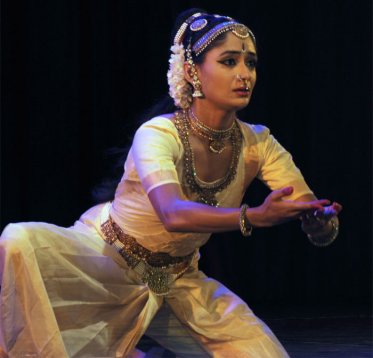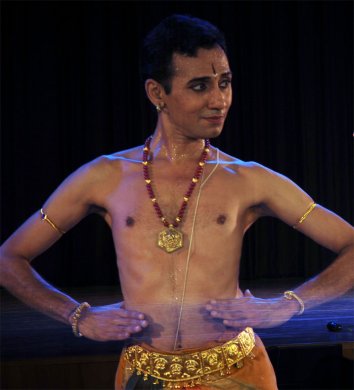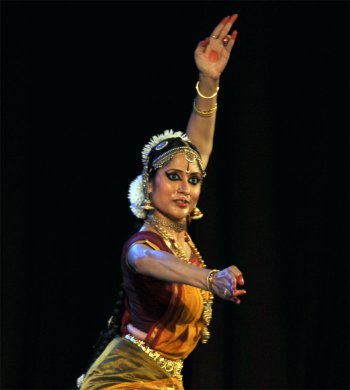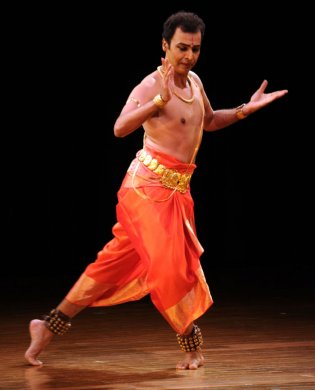
|   |

|   |
Madras Music Academy Annual Dance Festival 2015: Cat-Eyed Nayikas, Kitschypudi and some good Male Energy - Veejay Sai e-mail: vs.veejaysai@gmail.com Photos: Thanthoni January 22, 2015 Going by the Academy’s odd programming it wasn’t surprising to see a dancer like Sandhya Raju dancing in the mid-morning sub-senior slots. One wonders what about her dance even merited this placement! The more one saw her dance, the more one realized how much Sandhya Raju and Kuchipudi have less to do with each other. Like a nayika on a bad hair day, Sandhya decided to copy what looked like a queen’s maid from an old Telugu mythological flick. Every time a stanza in the opening Shiva Stuti concluded, the audiences were on the edges of their seats seeing Sandhya shiver on one leg trying hard to hold a pose. Sandhya was a record breaker in the number of times she couldn’t hold herself stable. Added to this was good old Srikant Gopalakrishnan’s mispronounced singing. He would launch into ‘Shivudu thandavam aadenu’ and blur the rest of the lyrics showing how less Telugu he knew. In a shoddy attempt at Tarangam, an integral part of the Kuchipudi repertoire, Sandhya tried telling stories of Shiva. From Gangavataranam to several others, she hurried through sequences till she got on to the brass plate. Not a single pada bedha, bhaumi charis was presented right. Even the very basic agratalasancharams, anchita, kunchita and suchi, samams were highly distracted by the clumsiness of her instability. Kishore Mosalikanti tried hard to keep pace with his excellent nattuvangam. With such school level grammar wrong, what was she even doing in the sub-senior slot is a million dollar question. In her Eka Patra Kelika, all one heard was the clear mispronunciation of singer Srikanth crooning away ‘Apudu terichenu kanulu adi devudu.’ If he sang any slower, he might as well have renamed himself ‘Slowkanth.’ So slow and tedious was the choreography of this piece that Sandhya overstretched her time and had to cut out her last piece. A fairly packed hall murmured a sigh of relief for the trauma of having to sit through Sandhya’s ‘Kitschypudi.’  Sandhya Raju  Jyotsna Jagannathan The next morning, Jyotsna Jagannathan’s dance was much refreshing from the last. She opened with a Mallari in Ghambhira Nattai and misra triputa thalam. With one too much of posing, the pace of the Mallari slowed down drastically making it feel like Jyotsna lacked the initial energy. In the presentation of an oft-performed Tanjore Quartet varnam ‘Samiyai azhaithu vaadi,’ Jyotsna’s energy was more pronounced. It wasn’t too long ago when I saw her being much more clinical and literal in her dance. This seems to have changed for sure. One saw much more gentleness and grace in her dance this time around. As the nayika tells her sakhi about her lover singing ‘Saamanya dora alladi,’ one saw the pride she displayed for her love. Gods and celestial beings played as her lover Shiva danced away. He might have been the graveyard-dwelling Chandala but to her love struck eyes, he was the most handsome thing she ever came across. Jyotsna depicted the nayika efficiently. While we saw Jyotsna’s clear lines and nritta, Vijayaraghavan’s disproportionate jathis became a bane to sit through the piece. Blindly adding elongated mridangam chollus doesn’t make the jathis any more interesting than what exist. One wishes Jyotsna also explored the stage space more effectively rather than swing in a column in the middle too much and too often while doing her sancharis. In a refreshing twist to her show, Jyotsna presented a beautiful composition of the 14th century Mythili poet Vidyapati. Exploring adbutha rasa, Vidyapati writes ‘E sakhi pe khale ek aproop, suna ita maanabi saapana swaroop’, where the nayika is pinching herself to reality seeing the beauty of nature. While Jyotsna tried hard to give her best, the piece was ruined by K Hariprasad’s strongly accented singing of Hindi/Mythili lyrics. He seemed totally uninvolved in the song or its lyrics and instead used the ragam Kapi to demonstrate his prowess. Jyotsna could easily rework this piece with a singer who has his pronunciation perfect to bring out the beauty of Vidyapati’s poetry. A newfound grace has seeped into her dance, thanks to the mentoring of her new Guru Malavika Sarukkai. One hopes she doesn’t pick up the wrong things in the process that many guru-hopping students end up doing, blindly imitating their new gurus. If she can stay focused and work harder, Jyotsna is a star in the making and someone to look out for in the coming decade. The next morning saw an excellent performance of the first male soloist for the festival. Bangalore based P. Praveen Kumar’s recital opened with the long-lost sabdam. Sabdams have been slowly fading out of the dance stage as many dancers either find it too difficult to learn or are too busy trying to do vague new things in their dance. In that light, it was refreshing to see the revival of a sabdam. A colour-coordinated orchestra added liveliness from the very beginning. In his main piece, Praveen took up the challenge of choreographing the famous daru varnam ‘Mathe malaya dhwaja’ composed by Harikesanallur Muthaiah Bhagavatar. An excellent flute prelude by Mahesh Swamy took us into the world of ragam Khamas. Praveen explored various stories of the Devi in his sancharis. In his portrayal of Mahishasura Mardhini to the lines ‘Shaatodari Shankari Chamundeshwari’, Praveen’s clever choreography made it exciting to watch. Even the fast paced jathis were gracefully managed. However, the second half of the varnam ‘Shyaame sakala bhuvana saarvabhaume’ seemed to swing in the same tempo as the first half. If he can rework the sancharis in the second half, this varnam performed by him is worth watching as no other dancer has explored it the way Praveen has. In his presentation of Kshetrayya’s famous padam ‘Ososi,’ Praveen could have worked better on his abhinayam which felt a little bit too scattered. In a new choreography titled ‘Ananga Vilasa’ compiled by his guru C.V. Chandrasekhar, while the idea of the piece was excellent, the implementation seemed to have gone for a toss. Set to Ragamalika and Talamakila, ‘Ananga Vilasa’ was an ode to Manmadha, the god of love. With selections from Soundarya Lahiri, Amarakosham and other writings, the production needed a tighter knitting than what was presented. It came forward as a patchwork of several ideas that couldn’t work as a cohesive unit. We hope Praveen can rework this piece and present it. Lingaraju’s mridangam, Balasubramanya Sharma’s singing (which surprisingly didn’t blur the lyrics) added to Mandya Nagaraj’s excellent violin made Praveen’s performance a pleasure to watch.  Praveen Kumar  Janaki Rangarajan The rasikas had to fall back with a loud thud from the great heights of watching Praveen’s performance. This effortless descent was caused by US based Janaki Rangarajan’s show. What welcomed audiences was a nayika who walked straight out of Andrew Lloyd Weber’s ‘Cats’, eye make-up, scary looks, false coyness et al. She began a frontal attack with an alarippu ending in a Thiruppugazh. Even if the great Arunagirinathar didn’t mean to scare anyone away with his bhakti, Janaki’s dance came piercing into the audiences like Muruga’s spear. After the Murugan shock therapy came the main piece, a varnam ‘Mohalaagiri konden’, a composition of the Tanjore Quartet set to Todi ragam. But wait! Before that we had a scary announcement from the wings. The unknown announcer seemed straight out of a warzone giving evacuation orders! Much as she goes around telling she does not perform her guru Padma Subrahmanyam’s style of Bharatanrithyam anymore, Janaki inevitably gets into it. Guess it might be easy to take Janaki out of that style but impossible to take Padma’s Bharatanrithyam out of Janaki. She danced away in a freewheeling attempt at the varnam. We saw the nayika plead to her lover that he was like her life breath like the fish had water, we saw lord Rajagopala get dressed in a mix of slow, fast and ultra fast pace and much more. In the second half of the varnam, Janaki got more aggressive in her stance leading to fault in her rhythm. She kept walking back casually trying hard to please an already scared audience. The rasikas had to choose between looking at faulty footwork or a scary hassled cat-eyed nayika threatening another attack. Towards the conclusion of the varnam, the nayika takes the stage center burning in her own heat of passion. What an abrupt end! Just as audiences thanked heavens for the piece ending, the announcer threatened a warning of another item. This time a Sarangapani padam ‘Intha moham yemira’ set to ragam Shankarabharanam. With Hariprasad’s singing one didn’t know if Kshetrayya wrote the padam in Telugu, Malayalam or... Singers who don’t know a particular language must either practice well enough before attempting to sing or must avoid it totally. Instead, Hariprasad crooned away as Janaki portrayed yet another nayika. “Tell me, is she that beautiful?” asks the nayika, in a bantering mood, taunting the lover about his obsession for another woman. Here we had Janaki slap enough choonam (lime) on the paan leaf to give poor Venugopala a sore tongue for a long time. Audiences eagerly waited for the morning to end before the announcer could unleash another threat and scare them out of their wits.  Vaibhav Arekar
The second and last male soloist for the festival followed the next morning. Vaibhav Arekar from Mumbai always manages to put together a show with content that is different from most others. This time he opened his show with an item he learnt as a student of Nalanda Institute in Mumbai. ‘Pillayar Stuti’ set to a Ragamalika and khanda chapu talam by the great nattuvanar and teacher Kadirvelu Pillai was a part of his regular classroom warm-up exercises for students. Vaibhav smartly reworked this piece with Kadirvelu master’s able sons Kalishwaran Pillai and Dakshinamurthy Pillai, both accompanying him in the current performance and recreated it to suit a stage presentation. Presenting the oft-performed Tanjore Quartet varnam ‘Manavi chekona raada’ in ragam Shankarabharanam, Vaibhav explored the shringara bhakti of a nayika. A mishap with his existing singer forced Vaibhav to opt for Srikanth Gopalakrishnan. The same Srikanth who is perfect with his mispronunciation of sahityam this time took enough liberties with the ragam, going off shruti several times. Nevertheless, Vaibhav kept his choreography going. As the lines ‘Vinara shri Thanjapuri velayu Brihadeeshwara’ went, one saw the nayika slowly morph into a bhakta from someone pining for the lord’s love. Towards the end the nayika gains a color of stubbornness, almost childlike, and decides not to leave the presence of her lord. With much convincing abhinaya, Vaibhav managed to portray the various moods of the nayika effectively. This abhinaya heightened in his presentation of the Jayadeva ashtapadi ‘Priye Charusheele.’ Krishna requests Radha to give up her pride and seeks reunion as he tries to pacify a khandita. With some fantastic lighting by Sushant Jadhav and Vaibhav’s choreography, one saw the Chakora bird shedding tears as moonbeams fall on its eyes. Krishna’s sorrow of separation became pronounced when he saw a deer couple make love and his pining for Radha increases. He breaks all protocol and forces an embrace. Vaibhav’s choreography matched the heightened sense of mood that O.S. Arun’s music evoked. He concluded his performance with ‘Ritumala,’ an ode to the seasons composed by veteran Guru C.V. Chandrasekhar. As he went season by season, one saw summers, monsoons where peacocks danced in expectation seeing rain clouds and more.What stood out was the portrayal of dry leaves gently swaying in the wind as autumn sets in. With graceful movements of his hands and fingers, the mood of the season was suggested. However, the piece as a whole seemed to lack any cohesiveness in coming together. It might have been a pressure on time that Vaibhav hurried through the piece. With crisper editing, the piece could be presented in a better avatar. The last day of the academy’s festival had Uma Namboodripad Satyanarayanan’s performance in the mid-morning slot. Uma has grown from strength to strength over the years and watching her perform has become more pleasurable than ever. Under her Guru Chitra Visweswaran’s guidance, Uma has matured into a fine dancer. After an invocation to Ganesha, she presented the pada varnam ‘Roopamu joochi,’ the authorship of which continues to remain shuttling between Muthuswamy Dikshitar and the Tanjore Quartet. Keeping that controversy aside, we were welcomed into the serene mood of Todi by Mudikondan S Ramesh’s melodious veena. Playing the role of the nayika who sees Thyagesa in a procession and is smitten, Uma’s abhinayam was exemplary. Her costume made her frame seem bigger than it is. Rehearsing with costume is something that most classical dancers, especially in the south tend to ignore. Added to this in her nritta, a slight lack of energy was visible. Uma’s footwork for the varnam needed to be infused with more punch and clarity which she is very capable of. The second half of the varnam remained in the same pace as the first owing to Srikanth Gopalakrishnan’s slack singing making it a rather tedious affair. Despite Sukanya Ravinder’s excellent nattuvangam the energy of the whole piece didn’t pick up. In the abhinaya of a khandita, the nayika asks Muruga if he has exhausted his love for her in the padam ‘Soodukara kalli’ set to Panthuvarali ragam. Uma’s expressions were excellent though a waning energy was visible. In her attempt at Papanasam Sivan’s ‘Enna thavam seidane’, Uma’s choreography of the piece reminded one of her performing ‘Jagadho dharana.’ Mother Yashoda putting Krishna to sleep, Krishna eating mud, getting taunted, revealing the Vishwaroopam and so forth. Why was most of the choreography repeated or predictable? This piece needed reworking at various levels, which once again Uma is very capable of doing. A Thillana in Hamsanandhi by the famous GNB was a fitting finale to her performance. The mid-morning slots, despite some run of the mill singers and an odd bad dancer, remained the best in the entire academy schedule. These were a bunch of young stars with much needed passion, commitment and involvement. Some of these surely stick out as the next generation stars. Veejay Sai is a writer, editor and culture critic. |